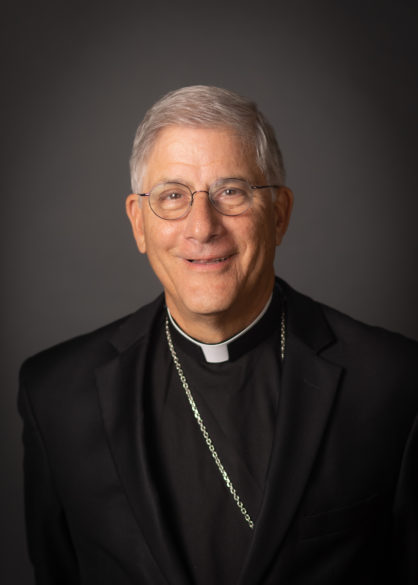Por Obispo Joseph R. Kopacz, D.D.
La Conferencia Anual de Obispos en Baltimore, recientemente concluida, estuvo repleta de reuniones, presentaciones, elecciones a varios comités, actualizaciones e impactos con respecto a las secuelas de las elecciones nacionales, y conversaciones en muchos niveles sobre los caminos a seguir para la Iglesia Católica en los Estados Unidos. Es un ambiente muy dinámico que tiene las características de un caleidoscopio colorido, excepto que en esta reunión las partes móviles están todas vestidas de negro. Sin embargo, en los últimos años, los que planifican el evento anual, a instancias del cuerpo de obispos, han incorporado más tiempo para la oración silenciosa, la adoración eucarística, las comidas relajantes y algo de ejercicio. Como siempre, las Misas diarias proporcionan el ancla para todas las actividades que siguen en el transcurso de un día.

Cada vez que la Conferencia Nacional de Obispos se reúne, el nuncio apostólico se dirige al cuerpo reunido. El cardenal Christophe Pierre ocupa actualmente el cargo de nuncio como embajador del Papa Francisco ante la Iglesia en los Estados Unidos. Su mensaje es siempre una ventana a las enseñanzas recientes del Santo Padre, a los acontecimientos pertinentes en la Iglesia en los Estados Unidos y en todo el mundo, y una visión general de la Iglesia en relación con el mundo moderno. Por supuesto, un logro significativo en nuestro tiempo es el recientemente concluido Sínodo sobre la Sinodalidad, un viaje de tres años que produjo un documento final para guiar a la Iglesia desde adentro y alentar el diálogo profético con el mundo moderno. Habrá mucho que desempacar, estudiar y aplicar en un futuro predecible.
En su discurso, el cardenal Christophe señaló el próximo Año Jubilar de la Esperanza que será inaugurado por el Papa Francisco en la fiesta de la Sagrada Familia el 29 de diciembre de 2024. El Santo Padre ha escrito un documento maravilloso para este Año de Favor y Gracia del Señor, titulado Spes non Confundit, o La Esperanza no Defrauda. (Romanos 5:5)
El contexto completo de esta audaz proclamación de fe se encuentra en el siguiente pasaje. “Justificados por medio de la fe, tenemos paz con Dios por medio de nuestro Señor Jesucristo, por quien hemos tenido acceso a esta gracia en la cual estamos firmes; en la esperanza de participar en la gloria de Dios … La esperanza no defrauda, porque el amor de Dios ha sido derramado en nuestros corazones a través del Espíritu Santo que nos ha sido dado”. (Romanos 5:1-5)
El Papa Francisco ofrece esta reflexión sobre las inspiradas palabras de San Pablo a los romanos. “Con espíritu de esperanza, el apóstol Pablo dirigió estas palabras de aliento a la comunidad cristiana de Roma. La esperanza es el mensaje central del próximo Jubileo que, según con una antigua tradición, el Papa proclama cada veinticinco años. Mi pensamiento se dirige a todos los peregrinos de esperanza que viajarán a Roma para vivir el Año Santo y a todos los demás que, aunque no hayan podido visitar la ciudad de los apóstoles Pedro y Pablo, lo celebrarán en sus iglesias locales. Que el jubileo sea para todo un momento de encuentro auténtico y personal con el Señor Jesús, “la puerta” (cf. Jn 10, 7.9) de nuestra salvación, a quien la Iglesia tiene el encargo de proclamar siempre, en todas partes y a todos como “nuestra esperanza”. (1 Timoteo 1:1) (Spes non Confundit)
Para el cristiano, la esperanza nace del amor y se basa en el amor que brota del corazón traspasado de Jesús en la cruz: “Porque si siendo enemigos, fuimos reconciliados con Dios por la muerte de su Hijo, mucho más cierto, reconciliados, seremos salvados por su vida”. (Romanos 5:19)
Junto con el Jubileo de la Esperanza, el nuncio también se basó en la más reciente encíclica del Santo Padre sobre el Sagrado Corazón de Jesús, Delixit Nos, (El Señor) Él nos amó. “El símbolo del corazón se ha utilizado a menudo para expresar el amor de Jesucristo. Algunos se han preguntado si este símbolo sigue siendo significativo hoy en día. Sin embargo, viviendo como vivimos en una época de superficialidad, corriendo frenéticamente de una cosa a otra sin saber realmente por qué, y terminando como consumidores insaciables y esclavos de los mecanismos de un mercado despreocupado por el significado más profundo de nuestras vidas, todos necesitamos redescubrir la importancia del corazón”. (Delixit Nos)
Cuando el corazón está envalentonado por la gracia de Dios, podemos enfrentar un futuro incierto mejor equipados para evitar los campos minados de la incredulidad, la duda y el miedo. Una vez más, el Santo Padre anhela llevar sobre sus hombros un mundo sumido en la oscuridad y la división a la luz de un nuevo día impregnado del corazón y la esperanza del Evangelio.








